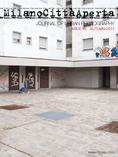tools and techniques progetto urbano newsletter landscapes large scale plans & projects economics commerce inu simulation urban market urban growth anthropology ecology infrastructures creativity ricerca strategic planning urban practices scenarios participation premio letteratura urbanistica urban form public spaces social practices conservation & preservation
Issue #9 - AUTUMN/2011
from Milano Città Aperta
Milano Città Aperta | Journal of Urban Photography
Milan is defined by the Duomo and Piazza della Scala. More or less, this is what the old postcards that we find on our travels say. Our literature, cinema and those strangers met during a journey tell us that. Milan is the image of an infinite post-war economical growth that, today, still gives hope for many to dream. A city where the business hub of Piazza Affari lies; where the huge department store of La Rinascente stands with some of the most expensive fashion boutiques and stores in the world.
A tiny centre; the keeper of a major part of Italy's wealth seems to have been born out of nothing from the mist of the Val Padana. This is how the myth of Milan was established in the rest of Italy, along with the most stupid stereotypes in circulation that depict a city of millionaires.
Naturally, Milan isn't just this. Milan is its crown, its less beaten quarters with its urban blights and the little beauties found within its own parameters. Here, other stories that are slowly finding their own literature are told - through cinema, music and photography- still semi unknown amongst a complicated and contradictory city. Gratosoglio, l'Isola, Piazza Brasilia, il Bosco in Città , Santa Giulia. All, however, a part of Milan.
Whether it's needed or not, an urban geography has to be drawn that exceeds the idea of the centre 'caput mundi' and that which takes life, society and work into consideration even where there are lesser optimistic conditions. We should do that without having to build homes for the poor or thinking that the soul of a quarter isn't important. It's fundemental to expose some sense of truth. A house is not enough to live.
Perhaps, it's sufficient enough to take a walk in a park where people are celebrating a Muslim wedding in order to understand the different ethnic backgrounds that populate the city. Perhaps, we should take a walk in a public garden during the evening more often, when everything is still, under the shine of the electric street lights.
In this issue, we tell the story of Milan; it's much bigger than one would think. We'd like those to remember that to forget the extensions of the arms of our city beyond the Bastioni means that we forget its complex geography and all of its history.
Happy reading.
INDEX
• Il parco delle lune elettriche,
by Daniele Faverzani
The new lights of public parks make for mysteriously coloured nocturnal landscapes. These lights have been installed in order to prevent crime, they don't bring citizens together, instead they leave the park wondrously illuminated but absolutely deserted.
• Bosco in città,
by Thomas Pagani
Bosco in Città is an oasis of green space that fills with colour during the summer. It's only a few kilometeres from the centre of Milan. It's an experiment of coexistence between diverse environments, in between the Mitteleuropa and Mediterranean Italy.
• Sweet home Santa Giulia,
by Giordana Gagliardi e Ambra Zeni
Santa Giulia is a neighbourhood without shops, transport, cinemas and supermarkets. Only houses. Naturally, one would say that this is a result of the financial crisis.
• Ritratti di case,
by Sara Moiola
Finnish style villas. Temporary prefabricated housing.
• Milano Downtown/Gratosoglio,
by Giovanni Hänninen
Gratosoglio: without direction. A neighbourhood of Milan that risks losing itself amongst its own urban blight. A photographic piece taken from one broader research project on the Grande Milano.
• Isola,
by Maria Vittoria Trovato
The neighbourhood of Isola had a story of its own amidst the geography of Milan; as if there were a sea around it. Today, the bridge, wanted by few, sacrifices (for the interests of real estate) its complex identity.
www.miciap.com




Planum
The Journal of Urbanism
ISSN 1723-0993
owned by
Istituto Nazionale di Urbanistica
published by
Planum Association
ISSN 1723-0993 | Registered at Court of Rome 4/12/2001, num. 514/2001
Web site realized by ChannelWeb & Planum Association | Powered by BEdita 3







